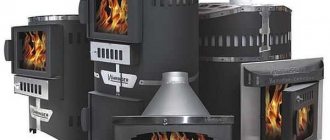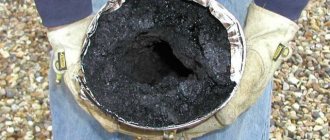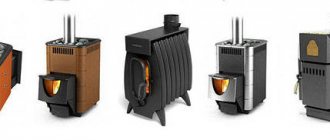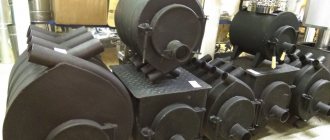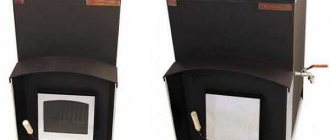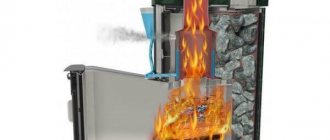Feringer stoves are recognized by experts and connoisseurs of baths as one of the best. They are available in several versions and have two categories:
- Ovens with a closed heater to create the atmosphere of a Russian steam room (temperature 55-70°C, humidity 40-75%). In the catalog they are located in the “Steam ovens” section.
- Stoves with an open heater for dry-air saunas (temperature from 80° and low humidity 10-15%). They can be found in the “Golden Ratio” section.
- Not so long ago, in 2011, a third line appeared - “Lamelle”. It is distinguished by the presence of a cladding made of natural stone, and some changes have been made to the design of the stove, allowing you to confidently heat steam rooms in log houses from sub-zero temperatures.
The stone fastening system of the new stoves is interesting: a holder with hooks is mounted on a stone cut into plates. These hooks are used to fix the stone slats in a special groove. The system is simple but effective, and installation is very easy and takes less than an hour.
This is what the new Feringer Lamel oven looks like
Design features
The first thing that catches your eye is the elongated shape and a rather voluminous firebox. Moreover, if you look at the Feringer sauna stove in a horizontal section, it turns out that the firebox is surrounded by stones on almost all sides. And the heat from the wall of the firebox is transferred to the stones, from them the screen is already heated, and then the room is heated by radiant heat from the screen. Therefore, there is no need to cover this metal stove with a brick screen, as is done when installing the vast majority of other models (the exception is the Kutkin stove).
Feringer furnace section
Another feature is the firebox without grates. This is because the top combustion principle is used. With this option, the firewood is lit not from below, as we are used to, but from above. This principle makes it possible to use the heat from burning wood to the maximum. In this position, the coals are constantly in the combustion zone. As a result, there are almost no unburned residues. If there are a few coals left, then only those that burned last.
The next design feature is the presence of a smoke tooth and a side combustion system. They also ensure that more heat goes to warming up the heater rather than escaping into the chimney. The side burning system is a special design in the firebox in which the coals do not lie in the center, but are scattered throughout the stack, igniting the wood lying on the side. After all, in wood-burning stoves this is the zone that burns the worst. In Feringer stoves, the entire surface of the wood burns.
The smoke tooth, located in the upper part of the firebox, twists the flame at the top in a spiral (look at the photo). In this way, the flame stays in the firebox longer, heating up the walls more strongly, and small remnants of it end up in the pipe. But the heat that inevitably ends up in the chimney can be used to heat the steam room. For this, Fehringer has several solutions:
- A heater on a pipe in a traditional and non-traditional design: with a mesh or a decorative carved screen.
- Controlled convector on a pipe. This is a device with a duct system around a main metal pipe.
Diagram of air movement during furnace operation
When installing a controlled convector at its very bottom, immediately after the stove is lit, boiling water is poured. As flue gases pass through, water turns into steam and enters specially formed lamella channels. Since moist air (steam) has a large heat capacity, passing along the wall, it takes away and transfers more heat. These flows contribute to faster heating of the steam room. But this device should only work during the warm-up stage. When they start steaming, it is closed (by turning the damper). By this time, all the water in the convector should have boiled away.
About Vöhringer production
Vöhringer is a modern plant in Voronezh, which since 2000 has been manufacturing wood-burning stoves for saunas and baths. The plant's products occupy a leading position in the market of heating equipment for steam rooms, and are in active demand both in Russia and abroad.
The founder of the creek is Arthur Pavlovich Feringer.
Feringer furnaces are performed on modern high-tech equipment, which ensures maximum precision of work and minimizes the risk of defects.
Vöhringer logo
The company's products are an example of the ideal balance of quality, functionality, performance and affordable cost. They have their own design features that distinguish Vöhringer stoves from models from other manufacturers:
- Special patented wood burning system. “Vortex” is a unique modern method of burning logs, in which the fire does not flow upward, but moves in a spiral and is held directly in the combustion chamber area. The flame spreads to each log and promotes high-quality combustion of firewood. The heating period of the bathhouse becomes shorter, fire safety is higher.
- Top ignition of wood. Many companies produce stoves with bottom ignition of fire in the combustion chamber. Feringer stoves are ignited from above, which affects the short heating time of the bath. The stones in the stove heat up very quickly, and heat enters the room.
- Firebox without grate. This makes fuel combustion better. Together with the special Vortex system and top ignition, up to 15% of fuel is saved.
- Clean glass firebox door. The glass is resistant to high temperatures and is produced by the German company Robux. Soot and soot do not accumulate on it, and it does not require special care.
- High quality raw materials. For the production of heating structures, stainless steel alloyed with titanium is used.
Design of Feringer stoves with a closed heater
In general, the firebox is formed mainly by stamping and bending methods, and has a minimum of seams. The seams are located in places with low temperature loads. All furnace elements are made of stainless steel with 17% alloy metal content.
In stoves with a closed heater, a cylindrical container for stones rests on the base of the stove and covers the firebox on all sides (except for the front part, where the extension or firebox door is installed). To regulate the air flow passing through the heater, there is an adjustable damper. With its help, you can reduce or increase the heating rate of the steam room. While intense heating is taking place, the damper is opened and hot air quickly warms up the room. The steam room is dried in the same position after the bath.
Construction of a furnace for a Feringer bath with a closed heater
When the required temperatures are reached, the damper closes completely or almost completely. The temperature is stabilized and the steam room conditions are maintained in the specified mode.
A smoke tooth is installed in the upper part of the firebox. This is a metal piece curved in the shape of the letter “L” at the top of the firebox. It allows you to twist streams of smoke and flame into a spiral. Because of this, the walls of the firebox warm up better, and the stones warm up from it. This tooth gives another positive result: the flame rises in the pipe only 30-70 cm (in stoves of a conventional design, the height of the flame in the pipe exceeds a meter, and sometimes one and a half to two).
Adjusting the combustion intensity
There is an adjustable damper above the door (1) and below it (2).
The burning speed of firewood can be changed by two dampers. One is located above the firebox door, the second below it. It is advisable not to close the upper damper completely: it ensures that there is no soot on the glass. Always leave at least a minimum gap of a couple of millimeters, and the glass on the door will always be clean.
These two dampers regulate the amount of air supplied to the firebox. The more air, the more actively the wood will burn. This mode is necessary at the stage of heating the steam room and stones. Then, when the temperature is close to the required one, they cover themselves and the wood smolders, maintaining the temperature of the stones and practically stopping the heating of the steam room.
Getting steam
Deep inside the heater is a device called a steam gun. This is an L-shaped tube with holes. Another tube is welded to it, which goes to the top of the heater. Water is supplied to it and converted into steam.
This is how a steam gun works
Through small holes in the horizontal tube, water flows into the hottest part of the heater - onto the lower stones. Their temperature is 500-550°C. As a result, tiny droplets are formed, which have a high temperature at the outlet. They are very small, they are almost invisible. This state of steam is called “light”. Probably because after vaping you feel light in your body and never have a headache.
Adjusting the temperature in the steam room
The atmosphere in a steam room consists of many components. The air and walls warm up from the radiation of the stove body and pipe, from the steam that is supplied to the heater. You need to change the temperature in the steam room by manipulating the modes of these elements. There are dampers/gates for this.
How to adjust the combustion intensity and heat transfer of the housing has already been explained (using the valves near the door). It is also necessary to control the air flow through the chimney convector. For this purpose, there is also a valve/gate in its upper part. By moving its handle to the right/left, you open/close, completely or partially, the lumen of the air tubes.
Devices for adjusting combustion intensity
The new Feringer stoves of the Lamel series have another powerful tool: the heater ventilation valve. At the initial stage, when the stones warm up, it is closed. The heater in this position is unventilated and the stones heat up to high temperatures. Then, to quickly reach the desired temperature, the valve opens. The air, passing through the stones, heats up greatly, quickly bringing the steam room to the desired mode. Once the required temperature is reached, the valve closes again and the stones are heated to produce steam.
While this is happening, the walls, floor, ceiling, and shelves are warming up in the steam room. As bath experts say: the steam room is infused. The temperature background of all its parts is equalized. It is in this state of affairs, when heat comes from the walls, and from the shelf, and from the ceiling, that the body warms up deeply. There is no heat. You feel only an even warmth that does not burn, like in a dry air vent, but envelops you, warming you up.
This is a live steam gun
The temperature drops slightly. But if it is within the normal range (50-55°), there is no need to raise it again: with each supply of steam it will jump by about 5°C. So, if you raise the humidity, you will also raise the temperature. And before steaming with brooms, you need to warm up two or three more times. During this time, it will grow another 10-15 degrees.
Design of sauna stoves - with open heater
There are fewer requirements for sauna stoves, and their structure is simpler. Their main task is to quickly heat the steam room to the required temperature, and then ensure its maintenance.
Design of sauna stoves from Fehringer
There is almost no steam in dry-air steam rooms; if you occasionally add one or two ladlefuls, then more for aromatization. Therefore, the volume of the heater is small - it should be enough to heat the steam room. They do not perform any other functions.
Adjusting the combustion intensity is the same as in sauna stoves: a valve above and below the fuel door.
Advantages and disadvantages
If we compare Feringer stoves for the “Russian bath” with heating equipment from other manufacturers, we will find a number of significant advantages:
- stylish outer casing;
- high energy efficiency of the device;
- guarantee of fire safety of the company's furnaces;
- there is no need to constantly clean the oven glass;
- high quality of materials and paint used to cover the body;
- complete tightness when the equipment door is closed;
- the ability to control the air supply during operation of the furnace.
- damper made of a gate, which reduces draft when the door is closed;
- uniform burning of wood in the product.
As such, there are no visible shortcomings in Feringer bath and sauna stoves, however, some users note that over time, on some models, the door latch begins to work poorly.
PLEASE ATTENTION! Also in the ovens there is a hole for laying stones that is too narrow for a human hand (you must use tongs).
Feringer oven models
This brand produces both sauna stoves - with a closed heater, and sauna stoves - with an open one.
Stoves with closed heater
The category of sauna stoves is called “steam stoves” by Fehringer. There are five options. Their technical characteristics are presented below. The price is indicated approximately in dollars due to exchange rate instability.
Furnace models
If we talk about modifications of stoves to create a Russian bath mode, then there are three models:
- Feringer Malyutka Steam for small steam rooms up to 16 cubic meters;
- Feringer Classic - for medium volumes - up to 18 cubic meters;
- Feringer Harmony for steam rooms up to 30 cubic meters.
All of these ovens have the same internal structure, only the dimensions differ. The stoves can be equipped with solid cast-iron doors, doors with glass or a panoramic screen (the result is a fireplace stove).
Technical characteristics of Feringer sauna stoves with a closed heater (to enlarge the table, right-click on it)
Lamel stoves are included in a separate category.” They also create the atmosphere of a Russian steam room. They are made entirely of AISI 430 stainless steel, 3 mm thick.
This is what the lamellas look like
In this option, you can order a stove with an open heater and a closed one, with a stacked lamella (from several pieces) or a solid one. The stone used is soapstone, serpentine, jadeite, marble and numerous combinations thereof. Moreover, the thickness of the finish can be different. Therefore, overall dimensions are not indicated.
Technical characteristics of Feringer Lamel sauna stoves (to enlarge the table, right-click on it)
In an open heater, the top of the container can be trimmed with metal or stone. The screen can be a regular size, or it can look like a fireplace portal. So the prices here are really “from” - the cheapest option.
Feringer wood stoves for saunas
These stoves have an open heater. In the catalog they are located in the “Golden Ratio” section. The table summarizes the main technical data; the price is indicated for the option with a standard door with transparent glass. It is possible to install a panoramic screen.
Technical characteristics of Ferniger sauna stoves (to enlarge the table, right-click on it) This is one of the sauna stoves - the “Golden Section” series
How to drown
Due to the unusual design - without grates, fuel loading and ignition in Feringer sauna stoves are different.
The firewood used is of short length, but they are stacked on top of each other, filling 3/4 of the volume. The firebox of the Mini model can accommodate logs up to 270 mm long, for Optima and MaxI - 310 mm. Both whole logs with a diameter of up to 18 cm and chopped into large and small pieces are used.
Before filling, the following are opened: the upper damper on the door, the damper on the chimney. Closed: the lower gate on the door and the heater purge valve (if there is a network). Coarsely chopped firewood is placed at the very bottom of the firebox. You can put one whole log in the Optima and Maxima fireboxes, and surround it with medium-sized fragments. The thinnest ones are placed on top. Several crumpled paper sheets are placed on top of the wood pile. They are lit. They close the door and wait for the wood to burn.
How to stack firewood in the firebox
After the wood starts to burn, a hum is heard. It means that there is too much oxygen, the combustion is too strong. Therefore, the gate at the top of the door must be gradually closed. With the optimal amount of air, the hum disappears. If the chimney in the bathhouse turns out to be very high (above 8 meters), then the adjustment is carried out with a chimney damper (until the hum is eliminated).
If there is an economizer on the pipe, after reaching normal combustion mode, you can begin to humidify the air and activate heating of the steam room. To do this, boiling water is poured into the economizer tray. The oven is left in this mode until the desired temperature is reached. The duration of warming up depends on how correctly the stove is selected, how it is installed, and how the steam room is insulated.
How is a clean glass system achieved?
There are several options:
- A gap, valve or other air flow above the glass. Due to this, the “cold” air that penetrates through the inlet flows down the glass. Due to this, it cuts off all smoke and flames from the glass;
- The glass does not fit very tightly in the frame. The glass, due to the negative pressure in the combustion chamber, is pressed away from the frame to allow air to penetrate. And the air begins to work according to the first principle.
- There is an option when the valve is lower than the glass, but in most cases this option does not work.
What about iron?
The furnaces use high-alloy stainless steel AISI 430. Due to this, their service life is very long. Clients come in whose ovens last 10-12 years. And this is during normal use, not once every few months.
The firebox is reinforced with stiffening ribs. The firebox may deform over time, but only slightly. This does not affect the work.
Reviews from owners of Feringer sauna stoves
We did not take into account the impressions about using the stoves that are on the manufacturer’s website. We present only those posted in discussions on the forums.
I had a Malyutka with a closed heater. Great stove. But then Lamel appeared, and I bought it for my new bathhouse, and with a portal. It looks very nice in the rest room. Compared to Malyutka, it takes 20-30 minutes longer to heat. But I now have an Optima, and this comes with the cladding of an additional 200 kg of stone. My wife likes it better, she says the warmth has become softer. But I miss the powerful sound when steam comes out that Malyutka had. This one has enough steam, but there is no sound. I'll remake this model of the gun so that it also hisses. But these are my problems, but everything works fine.
Philip, Priozersk
What I like is that the Lamel can be installed without a screen. I measured mine with a pyrometer. The lid at the top (I have a stone one) heats up to 170°, the lamellas at the top up to 120°, the middle - up to 70°. So everything is fine with fire regulations. You just need to insulate the combustion tunnel well. Here it is heating up harshly.
Nikolay, Moscow
Today I heated the Lamelya Optima bathhouse after a three-week break. During this time it froze completely. Everywhere it was -10-12°C. It took me two bookmarks and three hours. Only then did we go to take a steam bath. The temperature was already around 45°. While we were warming up, she grew up. But I won’t take any more breaks like this. It took a long time for everything to thaw out.
Vladimir, Peter
